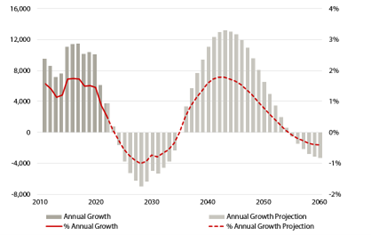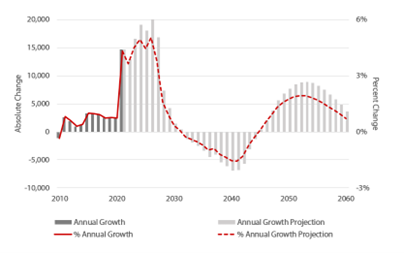Blog Post
Insight: The Future of Utah’s School and College-Age Population
By Heidi Prior
Dec 28, 2022 – Utah’s population will add more than 284,000 school and college-age individuals between 2020 and 2060, according to long-term planning projections published by the Kem C. Gardner Policy Institute. The variations in these populations over time reflect the impacts of birth patterns and migration over time. This blog summarizes projected changes in Utah’s school-age (5 to 17) and college-age (18-24) populations, which are explored in more depth in this research brief.
Figure 1. Utah School-Age and College-Age Estimates and Projections, 1980-2060
Source: Kem C. Gardner Policy Institute State and County Projections, 2020-2060
School-Age Population Change
Between 2020 and 2060, Utah’s school-age (age 5 to 17) population is expected to add nearly 106,000 additional residents; however, this change is small compared to the rest of the state’s population. Over the next four decades, Utah’s school-age population will grow by 15% while the state as a whole will grow by 66%. In fact, Utah’s school-age population will grow slower than any other age group in the state. As a result, by 2060, school-age residents will compose 15% of the state population, down from 21% in 2021.
Figure 2: Annual Absolute and Percent Change in Utah School-Age Population, 2010-2060
Note: School-age reflects populations ages 5 to 17.
Source: Kem C. Gardner Policy Institute State and County Projections, 2020-2060
The school-age population’s moderate growth makes more sense after considering the changes projected for each year of the 40-year period. As seen in Figure 2, the school-age population will not grow continuously across the projection period. Utah’s school-age population is expected to enter a period of decline beginning in 2024 and decrease for over a decade before resuming growth in the mid-2030s.
College-Age Population Change
The college-age, or 18-to-24-year-old population, is projected to increase by almost 178,000 residents between 2020 and 2060. Though this 52% increase is larger than projected school-age population growth, it still lags behind the 66% increase projected for the total state population. As a result, the college-age share of the state population will drop from 11.5% to 9.5%.
Figure 3: Annual Absolute and Percent Change in Utah College-Age Population, 2010-2060
Note: College-age reflects populations ages 18 to 24.
Source: Kem C. Gardner Policy Institute State and County Projections, 2020-2060
Currently, Utah’s college-age population is experiencing rapid growth, adding between 10,000 and 20,000 new residents each year. Projections show college-age growth slowing in the early 2030s and entering a 13-year period of decline. In the mid-2040s growth is expected to resume, though at a more moderated rate than this group experiences today.
Differences between Counties
While the statewide perspective is useful, each county experiences changes to these two populations differently. Insights about these populations in each county are available in the research brief. Use the link at the top of this blog to access the document.
Heidi Prior is a research associate at the Kem C. Gardner Policy Institute.









